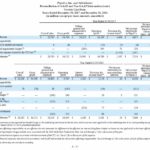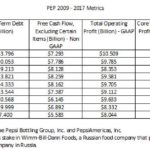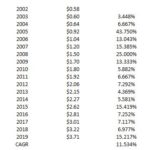Contents
Summary
- PEP released its Q4 and FY2017 results on February 13, 2018. Organic revenue, which excludes the impact of various items, grew 2.3% versus 3.7% in FY2016, and 5% in FY2015.
- FY2017 Adjusted EPS amounted to $5.23 versus $4.85 in FY2016. PEP’s adjusted EPS includes a one-time $1.70/share benefit from a provisional net tax expense related to the Tax Cuts and Jobs Act (TCJ).
- Diluted EPS (GAAP) amounted to $3.38 in FY2017 versus $4.36 in FY2016.
- While FY2017 FCF amounted to ~$7.3B, this level is lower than FCF reported in FY2012 – FY2016.
- Long-term debt has increased over $13B since FY2011 and PEP’s credit ratings from Moody’s and Standard & Poor’s are lower than in early 2010.
- PEP has increased its annual dividend payments by $1.74B since FY2009 and has rewarded its shareholders with a ~11.53% CAGR in its dividend since 2002 (includes recent dividend increase).
Introduction
PepsiCo, Inc. (NASDAQ: PEP) released its Q4 and FY2017 results on February 13, 2018 and also provided guidance for FY2018.
Its products are sold in 200+ countries and territories, and it has 22 billion-dollar brands.
PEP is known for its portfolio of beverage and snack brands. It and Coca-Cola (NYSE: KO) dominate the global non-alcoholic beverage market; each has a low 20% market share.
North American carbonated soft drink consumption continues to be sluggish and ever increasing competition from niche players has presented PEP with recent volume challenges. Its brand strength, however, remains intact.
PEP is expanding its international presence and product portfolio. Significant investment is being made in developing e-commerce capabilities. In addition, PEP is spending heavily on R&D and social and digital marketing and design.
PEP continues to innovate among its ancillary brands as evidenced by a host of new products. A specific example of PEP’s continuous innovation is the recent launch of bubly, a new sparkling water that ‘combines refreshing and delicious flavors with an upbeat and playful sense of humor to shake up the sparkling water category while keeping it real with no artificial flavors, no sweeteners, and no calories’.
The rationale for PEP’s focus on ‘healthier’ products (~45% of sales) in recent years is to more closely align with consumer trends. While it categorizes some of its products under ‘Good for You’ and ‘Better for You’, a review of the ingredients on the packaging reveals that many of PEP’s products within these two categories are really not that healthy. The ‘healthy’ aspect of these new products is relative to what PEP has historically been selling consumers.
Q4 and FY2017 Financial Results
Highlights of PEP’s results can be found in its February 13, 2018 Earnings release and in the Reconciliation of GAAP and Non-GAAP Information (unaudited) document.
 Source: Q4 and FY2017 Results and 2018 Financial Outlook
Source: Q4 and FY2017 Results and 2018 Financial Outlook
While PEP reported an increase in its adjusted net income attributable to each diluted PEP common share, $1.70/share of the increase is the result of a provisional net tax expense related to the TCJ Act.
PEP 2009 – 2017 Metrics
While PEP has certainly rewarded shareholders over the years, I notice the following negative trends.
- Sales have actually pulled back from FY2011 – FY2014 levels;
- Long-term debt has ballooned in recent years;
- Diluted EPS (GAAP) and adjusted EPS (non GAAP) are not on a steady upward trajectory despite the significant reduction in the number of Diluted Weighted-Average Common Shares Outstanding.

I recognize PEP held ~$19.5B in cash and short-term investments as at December 31, 2017 versus the $33.796B in long-term debt (a $14.296B variance). PEP, however, only had ~$7.4B in long debt in FY2009 versus $4.135B in cash and short-term investments (a $3.265B variance).
In addition to the negative trends reflected above, PEP is projecting $6B of FCF for FY2018 which will be at the lowest level since FY2009.
In reviewing PEP’s schedule of long-term debt obligations, it is apparent PEP has benefited from the extremely low interest rate environment. While 50%+ of PEP’s long-term debt is at rates between 3.7% - 3.9% and a significant proportion is not due until 2022 – 2046, it remains to be seen at what rates these debts will need to be renegotiated if we enter a prolonged period of rising interest rates.
FY2018 Outlook
On the February 13, 2018 conference call management indicated it is projecting the following for FY2018:
- organic revenue growth to be at least in line with the 2017 2.3% growth rate;
- foreign exchange translation is expected to have a neutral impact on revenue and EPS;
- a core effective tax rate in the “low 20s,” reflecting benefits of the TCJ Act with the benefit of the TCJ Act to be substantially reinvested in initiatives to benefit the Company’s U.S.-based front line workforce and to increase the Company’s capabilities;
- core EPS (non GAAP) of $5.70. This represents a 9% increase from PEP’s 2017 core EPS of $5.23;
- ~$9B in cash from operating activities and ~$6B in FCF. This is based on net capital spending of approximately $3.6B and a discretionary pension contribution of $1.4B;
- ~$7B in total cash is expected to be returned to shareholders in the form of dividends and share repurchases.
Credit Ratings
On February 24, 2010, Moody’s lowered PEP’s long-term rating to Aa3 from Aa2. Moody’s further downgraded PEP from Aa2 to A1 in June 2013. In January 2018, Moody’s reaffirmed PEP’s long-term debt rating as A1.
On March 17, 2010, Standard & Poor’s lowered PEP’s corporate credit rating to A from A+. It raised PEP’s corporate credit rating from A to A+ in April 2017 and still rates it at that level.
Both ratings are at the top end of the upper medium grade investment grade category. These ratings are 4 notches below the coveted AAA credit rating.
Free Cash Flow (FCF)
Please refer to the chart under the PEP 2009 – 2017 Metrics section of this article to view PEP’s FCF trend. As previously noted, PEP’s management has forecast ~$6B in FCF for FY2018.
As per PEP’s Q4 and FY2017 Results and 2018 Financial Outlook Press Release, PEP provides the following commentary with respect to this important metric.
‘FCF is net cash provided by operating activities less capital spending, plus sales of property, plant and equipment. Since net capital spending is essential to our product innovation initiatives and maintaining our operational capabilities, we believe that it is a recurring and necessary use of cash. As such, we believe investors should also consider net capital spending when evaluating our cash from operating activities.
Free cash flow is used by us primarily for financing activities, including debt repayments, dividends and share repurchases. Free cash flow is not a measure of cash available for discretionary expenditures since we have certain non-discretionary obligations such as debt service that are not deducted from the measure.’
Source: Q4 and FY2017 Results and 2018 Financial Outlook
Valuation
FY2017 Diluted EPS (GAAP) and adjusted Diluted EPS (Non GAAP) amounted to $3.38 and $5.23 respectively. Management has forecast adjusted Diluted EPS of $5.70 for FY2018 which represents a ~9% growth from $5.23.
PEP closed at ~$111 on February 16, 2018. Based on FY2017’s adjusted EPS of $5.23, PEP is currently trading at an adjusted PE of ~21.22. On the basis of management’s FY2018 forecast of $5.70, we get a forward adjusted PE of ~19.47.
Dividend, Dividend Yield, and Dividend Payout Ratio
PEP’s dividend history can be found here.
PEP typically announces an increase in its annual dividend in February when it releases its FY results. The dividend increase occurs with the 2nd dividend payment (June) of the calendar year.
In February 2018, PEP announced that it had increased its $3.22 annual dividend by 15% to $3.71; this represents the 46th consecutive year in which PEP has increased its annual dividend. The compound annual growth rate (CAGR) of PEP’s dividend has, therefore, been calculated on the basis of 2 dividend payments in one calendar year and two dividend payments in the following calendar year.
With PEP trading at ~$111/share, the current $3.22 annual dividend yields ~2.9%. The new $3.71 annual dividend provides investors with a forward dividend yield of ~3.34%.
The $3.22 annual dividend represents a ~95% dividend payout ratio based on FY2017’s GAAP EPS of $3.38. It is, however, only ~61.6% of adjusted EPS (Non GAAP).
The $3.71 forward dividend is a ~65% dividend payout ratio based on PEP’s $5.70 forward adjusted EPS. This is in line with management’s target.
Shareholders can expect ~$5B in total dividends to be distributed in FY2018. This is ~$0.528B higher than the ~$4.472B level in FY2017.
Shareholders can expect ~$2B in share repurchases in FY2018 which is comparable to FY2017 but lower than FY2010 – FY2016.
PEP announced a new share repurchase program which provides for the repurchase of up to $15B of common stock between July 1, 2018 and June 30, 2021. This new program replaces the $12B repurchase program which commenced July 1, 2015 and which expires June 30, 2018.
Final Thoughts
PEP has rewarded its long-term shareholders with a steadily increasing stream of dividend income and capital appreciation. Between 2010 – 2017, however, the reduction of 176 million common shares (Diluted Weighted-Average Common Shares Outstanding) has been accompanied by a significant increase in long-term debt.
Given the low interest rate environment in recent years, it appears management has viewed the use of low interest rate debt to assist in the repurchase of outstanding shares as being superior to the use of cash and short-term investments.
I do not question PEP’s ability to continue to increase its dividend annually and to repurchase shares even if interest rates tick up several basis points. I do question whether PEP’s management will want to continue to increase its dividend and repurchase shares at the same pace evidenced in recent years. In my opinion, the recently announced 15% increase in PEP’s dividend is not sustainable; an annual dividend increase in the 5% - 7% is more likely. You should also note that share repurchases of $2B in FY2017 and FY2018 (projected) are below the annual share repurchase levels in FY2010 – FY2016.
Despite the stagnation in PEP’s top line, I expect PEP’s management will continue to steer the business in such a manner that PEP’s shareholders will continue to be rewarded over the long-term.
PEP is certainly not valued at levels evidenced in 2009 – 2012. I am of the opinion, however, that PEP is currently fairly valued at ~$111 (a ~9% retracement from its recent ~$122.50 high) and intend to acquire additional shares to add to our current holdings which were acquired in February 2009.
I hope you enjoyed this post and I wish you much success on your journey to financial freedom.
Thanks for reading!
Note: I sincerely appreciate the time you took to read this article. Please send any feedback, corrections, or questions to [email protected]
Disclaimer: I have no knowledge of your individual circumstances and am not providing individualized advice or recommendations. I encourage you not to make any investment decision without conducting your own research and due diligence. You should also consult your financial advisor about your specific situation.
Disclosure: I am long PEP.
I wrote this article myself and it expresses my own opinions. I am not receiving compensation for it and have no business relationship with any company whose stock is mentioned in this article.



